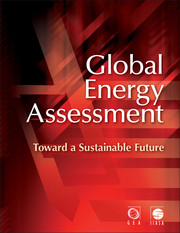Book contents
- Frontmatter
- Contents
- Section 1
- Section 2
- Section 3
- Cluster 1
- Cluster 2
- Chapter 7 Energy Resources and Potentials
- Chapter 8 Energy End-Use: Industry
- Chapter 9 Energy End-Use: Transport
- Chapter 10 Energy End-Use: Buildings
- Chapter 11 Renewable Energy
- Chapter 12 Fossil Energy
- Chapter 13 Carbon Capture and Storage
- Chapter 14 Nuclear Energy
- Chapter 15 Energy Supply Systems
- Chapter 16 Transitions in Energy Systems
- Cluster 3
- Cluster 4
- Section 4
- Index
- References
Chapter 15 - Energy Supply Systems
Published online by Cambridge University Press: 05 September 2012
- Frontmatter
- Contents
- Section 1
- Section 2
- Section 3
- Cluster 1
- Cluster 2
- Chapter 7 Energy Resources and Potentials
- Chapter 8 Energy End-Use: Industry
- Chapter 9 Energy End-Use: Transport
- Chapter 10 Energy End-Use: Buildings
- Chapter 11 Renewable Energy
- Chapter 12 Fossil Energy
- Chapter 13 Carbon Capture and Storage
- Chapter 14 Nuclear Energy
- Chapter 15 Energy Supply Systems
- Chapter 16 Transitions in Energy Systems
- Cluster 3
- Cluster 4
- Section 4
- Index
- References
Summary
Executive Summary
A sustainable future depends on more efficient use of the Earth's abundant energy resources in order to meet the rapidly increasing demand for energy services as well as to provide broader access to everyone. In 2005 the overall efficiency of the energy system from primary energy to useful energy was only about 34%. Owing to diverse geographic inequities in both sources and people, supply cannot always meet the demand where needed. Energy pathways from source through conversion, transmission, storage, and distribution to end-users are complicated and presently consist of numerous discrete pathways that differ widely for each energy source and carrier. These include solid fuels, liquid fuels, gaseous fuels (including hydrogen), electricity and heat. Aging equipment, congested networks, and extreme demands complicate this picture in many countries of the Organisation for Economic Co-operation and Development (OECD). Development of new infrastructure in both non-OECD and OECD countries will lock-in future dependence on conventional or non-conventional energy sources. This chapter aims to assist decision-makers by providing up-todate knowledge on the full range of energy pathways, their management, and operation. Energy systems to achieve a sustainable future should be made much more flexible in order to deal with societal needs and the probable deployment of technologies not yet commercially available (such as smart appliances, electric vehicles, fuel cells, and carbon capture and storage). Technology and policy solutions are available for supporting more energy for sustainable development, but in order to meet the transition necessary to avoid unacceptable events such as social unrest and/or climate change driven temperature rise, they should be put in place rapidly, and done in concert with each other.
- Type
- Chapter
- Information
- Global Energy AssessmentToward a Sustainable Future, pp. 1131 - 1172Publisher: Cambridge University PressPrint publication year: 2012
References
- 2
- Cited by



